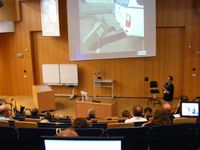Tag:amenity=university
| Description |
|---|
| An educational institution designed for instruction, examination, or both, of students in many branches of advanced learning. |
| Rendering in OSM Carto |

|
| Rendering in OSM Carto |

|
| Group: education |
| Used on these elements |
| Implies |
| Useful combination |
| See also |
|
campus=* |
| Status: approved |
| Tools for this tag |
|
- For OSM activities by the scientific community, see Research.
The tag amenity=university is used to map a university: an institution of higher education, designed for instruction, examination, or both, of students in many branches of advanced learning.
How to map
Universities typically occupy a large area, so it is recommended to create an area around the entire campus=* with the amenity=university tag, plus a name=* tag at least. For a more complex multi-site facility then ideally it will be mapped using a multipolygon. There should not be a node and area for the same university.
Individual elements of the university should not be tagged with amenity=university but can be mapped with operator=* and the name of the university, for example operator=University College London. Land and building owned by the university but not used for university purposes (ie not used for teaching, research, administration or accommodation - although note the below on accommodation) should not be included in this boundary. Where a university owns land and building for investment or future use these should be tagged appropriately with operator=blar university.
When the university accommodates students on a separate site to the site where teaching and research takes place, then the tagging landuse=residential + residential=university can be used (also use operator=*). Where it is not easily discernible that residential land belongs to the university (no signs, barriers or other distinct features), consider avoiding mapping the area as a university. The building itself can be included in the university relation, and the operator tag used.
Buildings, entrances (entrance=*) highway=footway, highway=steps, amenity=parking gardens, bars, restaurants, shops, and much more besides may be mapped as usual within university area.
Faculties and departments
Current usage on taginfo indicates that users start mapping faculties with the key faculty=* and departments with the key department=*. As these are likely formalized values the suggestion is to use English words, replace spaces with underscores, don't capitalize and don't concatenate refs in the faculty tag (e.g. don't tag "09 Chemistry" but use "chemistry" and put "09" in the ref).
| The tag department=* is used for several meanings, which is discouraged. |
Number of uses in OSM
| faculty=* | department=* |
|---|---|
Complex areas
Many universities are spread around a city or a larger geographical area. There are currently multiple ways to map this:
- Use a multipolygon relation for the areas that define the university campus - works well for universities with well defined areas, including ones with disjointed parts[1].
- Use a multipolygon relation that also includes individual buildings (with role
 outer) that are not on a specific campus[2].
outer) that are not on a specific campus[2]. - Use a multipolygon relation that includes nodes as members - not fully correct as technically such multipolygons are not valid. Still, many data consumers can process them. In some cases node members may be extremely hard to turn into areas, maybe even de facto impossible (university uses just single room in building - "all you have is the door bell on the street level").
Separate campuses
Separate campuses (or the areas of separate campuses) can be included in the same multipolygon relation. Only use amenity=university on separate campuses (that are individually mapped as ways or relations) if they have separate students, courses and faculty: in this case mapping each campus as a amenity=university separately is appropriate[3]. Also use operator=* to indicate the university name.
Common mistakes when mapping a university
- Using amenity=university on each separate area/part of a single university campus
Incorrect: Each separate part of a single campus is not a separate university[4].
Correct: Map a university campus as a multipolygon relation with a single amenity=university tag. - Using amenity=university on every building of a university
Incorrect: each building is not a university.
Correct: Map each university building as building=university[5] and use operator=* to indicate the university name.
Similar tags and proposals
- amenity=research_institute - An establishment endowed for doing research.
- amenity=college - A place for "further education", usually a post-secondary education institution, rather than an institution of "higher education"
- amenity=school - Secondary and Primary schools, which use a similar tagging system.
- Proposed features/University Campus (tertiary education) - original proposal for this tag
- amenity=hospital - Hospitals can be large institutions comprising many buildings. We should follow a similar approach when mapping them
- building=university - buildings constructed as university buildings
- residential=university - residential area, added to landuse=residential
Example
University of Zurich (37345941
 37345941)
37345941)
Rendering
Footnotes
- ↑ example: AGH in Kraków
- ↑ example: Universität Tübingen
- ↑ example: III Kampus Uniwersytetu Jagiellońskiego, a campus that is part of Uniwersytetu Jagiellońskiego
- ↑ See One feature, one OSM element
- ↑ example: Jan Mouton Learning Centre, a building that is part of Stellenbosch University

